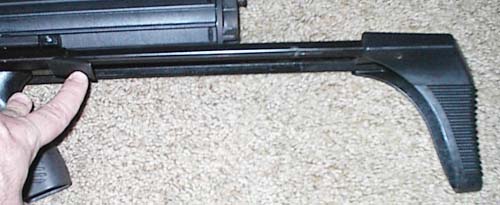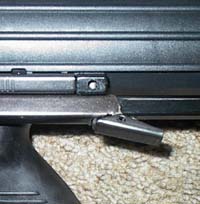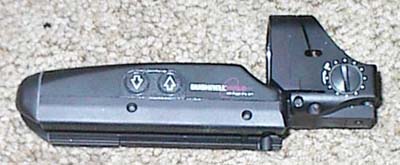
The Calico M-900 Carbine

|
Calico M-900 | ||||
| Caliber | Dimensions | Barrel | Weight | Magazine | Action Type |
| 9MM | 28-40x6.9x3.1 | 16.1" | 3.7 Pounds | 100 | Semi Auto |
As with the pistol version, a number of accessories are available, and the high position of the sights help to moderate recoil. The above photo shows the carbine with it's stock closed; the photo below shows it with the stock extended. The length of the weapon is 28" closed, and 40" extended. The longer barrel adds perhaps another 100-200 feet per second to the muzzle velocity of the 9mm.
 When collapsed, the stock rails fit into guides molded into the barrel shroud.
The stock is held in position by a simple latch on the left side of the weapon.
This latch is shown in the close up photos below. The other controls area
identical to those on the pistol version. Also in common with the pistol,
is the high quality of construction, and the use of modern polymers, and
alloys, which sets it apart from it's brethren.
When collapsed, the stock rails fit into guides molded into the barrel shroud.
The stock is held in position by a simple latch on the left side of the weapon.
This latch is shown in the close up photos below. The other controls area
identical to those on the pistol version. Also in common with the pistol,
is the high quality of construction, and the use of modern polymers, and
alloys, which sets it apart from it's brethren. In size, and deployment, this weapon could be considered as a rival of the Thompson, or the Sterling, though direct comparisons definitely show the age of these other designs. The Thompson weights nearly three times what the Calico does, while the Sterling is over twice the weight. These specifications are of the weapons with standard magazines (20-30 rounds), the addition of the 50 round drum pushes the weight of the Thompson up by several more pounds.
 Neither of these guns has the accuracy of the Calico, and both are susceptable
to corrosion. The Sterling, along with most sub guns, and carbines, uses the
traditional box magazine. The Thompson, too, uses a box magazine, though 50
and even 100 round drums are available. More details are given in the magazine
section, but in summation, the Thompson drums are much less robust, and of
considerably different design than that of the Calico. They are also considerably
heavier, and much more expensive. There is a "dummy" 10 round drum available
for the Thompson, for a shade over $100. This is for the collector who wishes
to have a Thompson of traditional appearance for show. Only the 1928 version
of the Thompson will accept the drum magazines, other versions use the stick
mags only. This is not a criticism of the Thompson, as I will likely add
a civilian version to my collection in the near future. It is merely what
I consider to be a realistic assessment and comparison of two weapons designed
at an interval of 70 years from each other. In common, both weapons were
cutting edge for their times, and both were designed to serve the same function.
Neither of these guns has the accuracy of the Calico, and both are susceptable
to corrosion. The Sterling, along with most sub guns, and carbines, uses the
traditional box magazine. The Thompson, too, uses a box magazine, though 50
and even 100 round drums are available. More details are given in the magazine
section, but in summation, the Thompson drums are much less robust, and of
considerably different design than that of the Calico. They are also considerably
heavier, and much more expensive. There is a "dummy" 10 round drum available
for the Thompson, for a shade over $100. This is for the collector who wishes
to have a Thompson of traditional appearance for show. Only the 1928 version
of the Thompson will accept the drum magazines, other versions use the stick
mags only. This is not a criticism of the Thompson, as I will likely add
a civilian version to my collection in the near future. It is merely what
I consider to be a realistic assessment and comparison of two weapons designed
at an interval of 70 years from each other. In common, both weapons were
cutting edge for their times, and both were designed to serve the same function. 
This particular example of the Calico is equipped with a scope mount (not shown in these pictures), and uses a Bushnell Holosight. The Holosight is an ideal system for this class of weapon, and is particularly well suited to the Calico because of the marginal sights, but exceptional accuracy of these guns. I had considered picking up a standard laser sight for the carbine, as I had for the pistol, but there are some shortcomings inherent in a laser sight. The most obvious of these is the poor daylight performance outdoors. A laser is fine for indoor work, day or night, and for outdoor work at night. Outdoors during the day, however, the range is limited to twenty feet or so. This is not a real handicap with the pistol, but wastes much of the advantage of the carbine. The Holosight generates a holographic image of a reticle on a small viewing screen. The image is unaffected by the range to the target, and is only somewhat affected by ambient light. The sight can be used day or night, indoors or outdoors, and even has ultra low settings for use with night vision devices. It is fitted to the standard Weaver base that makes up part of the Calico scope mount.
The model used is one of the older ones (the 400). It is a bit larger than the newer units, but is somewhat more flexible. The image formed is of a circle with a dot in the middle. Other reticles are available for the older models, but the newer versions have theirs permanantly mounted. There are 20 different brightness settings for everything from bright daylight, to moderate indoor lighting. For very dim ambient light, or use with night vision equipment, there is a filter included which will reduce brightness by a factor of 80. The aiming point of the sight may be adjusted in the same manner as on a telescopic sight. Click adjustments may be set for 1/4 moa on elevation, and 1/2 moa on windage. The sight takes two "N" type batteries. There is a battery check button, and an automatic shut off. All switches are of the membrane type. The unit is water resistant, but not water proof. The newer, smaller units are completely sealed, and waterproof, but I prefer the versatility of the interchangeable reticles in the older units. Along with the reticles, there is a rugedized hood available, the installation of which would make this identical with a model 450.

